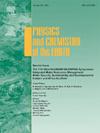Geophysical insight on the formation of a barrier-beach-dune system: The case of the central sector of the Kyparissiakos Gulf coastal zone (Western Greece)
IF 3
3区 地球科学
Q2 GEOSCIENCES, MULTIDISCIPLINARY
引用次数: 0
Abstract
The present study investigates the formation and development of a coastal barrier associated with the recent evolution of the beach/dune system of the Kyparissiakos Gulf (SE Ionian Sea, central Mediterranean Sea) during the late phase of the Holocene (Flandrian) transgression. The study is based on the application of combined geophysical (ERT: Electrical Resistivity Tomography; GPR: Ground Penetrating Radar) and geotechnical (CPT: Cone Penetration Test; boreholes) techniques, supported by sedimentological (granulometric, mineralogical, palaeontological) analyses. According to the interpretation of the collected and processed data, the formation of the coastal barrier started during the transition between the fast and slow phase of the sea level rise (i.e. 6-7 ka BP), which coincides with an increased fluvial sediment inflow induced by the prevailing wetter climatic conditions (8000 - 3700 BP). The development of the coastal barrier most likely involves a progradational beach, associated with the formation of dunes that follow aggradational phases of coastal barrier and beach evolution. Based on 14C dating, the formation of the two younger dune ridges took place no earlier than 350 and 950 cal yr BP, respectively.
对屏障-海滩-沙丘系统形成的地球物理见解:以希腊西部Kyparissiakos海湾海岸带中部为例
本文研究了全新世晚期(弗兰德里亚)海侵期间与Kyparissiakos湾(爱奥尼亚海东南部,地中海中部)海滩/沙丘系统近期演变相关的海岸屏障的形成和发展。该研究是基于联合地球物理(ERT:电阻率层析成像;探地雷达(GPR)和岩土工程(CPT:锥形穿透试验;由沉积学(粒度学、矿物学、古生物学)分析支持的钻孔技术。根据所收集和处理的资料的解释,海岸屏障的形成始于海平面上升的快慢阶段(即6-7 ka BP)的过渡阶段,这与当时较湿润的气候条件(8000 - 3700 BP)引起的河流沉积物流入增加相吻合。海岸屏障的发展很可能涉及一个递进海滩,与沙丘的形成有关,这些沙丘是在海岸屏障和海滩演化的递进阶段形成的。根据14C测年,两个较年轻沙丘脊的形成时间分别不早于350和950 cal yr BP。
本文章由计算机程序翻译,如有差异,请以英文原文为准。
求助全文
约1分钟内获得全文
求助全文
来源期刊

Physics and Chemistry of the Earth
地学-地球科学综合
CiteScore
5.40
自引率
2.70%
发文量
176
审稿时长
31.6 weeks
期刊介绍:
Physics and Chemistry of the Earth is an international interdisciplinary journal for the rapid publication of collections of refereed communications in separate thematic issues, either stemming from scientific meetings, or, especially compiled for the occasion. There is no restriction on the length of articles published in the journal. Physics and Chemistry of the Earth incorporates the separate Parts A, B and C which existed until the end of 2001.
Please note: the Editors are unable to consider submissions that are not invited or linked to a thematic issue. Please do not submit unsolicited papers.
The journal covers the following subject areas:
-Solid Earth and Geodesy:
(geology, geochemistry, tectonophysics, seismology, volcanology, palaeomagnetism and rock magnetism, electromagnetism and potential fields, marine and environmental geosciences as well as geodesy).
-Hydrology, Oceans and Atmosphere:
(hydrology and water resources research, engineering and management, oceanography and oceanic chemistry, shelf, sea, lake and river sciences, meteorology and atmospheric sciences incl. chemistry as well as climatology and glaciology).
-Solar-Terrestrial and Planetary Science:
(solar, heliospheric and solar-planetary sciences, geology, geophysics and atmospheric sciences of planets, satellites and small bodies as well as cosmochemistry and exobiology).
 求助内容:
求助内容: 应助结果提醒方式:
应助结果提醒方式:


